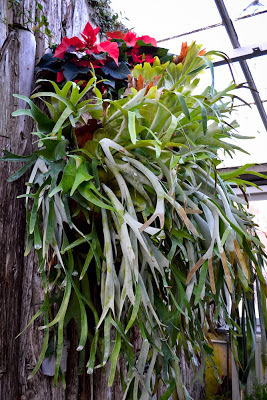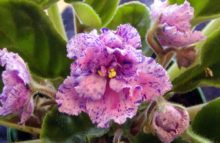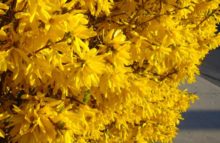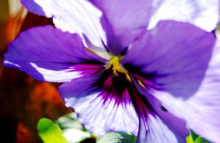| Staghorn Fern at Allan Gardens, Toronto. |
You know how certain plants call to you, and others don’t? I’d always been a little wary of Staghorn Fern Platycerium Bifurcatum. There was something a little creepy and non-plantlike about them that left me a little cold, but I never forgot how much they appealed to my father, on trips to Allan Gardens Conservatory. He’d say “I’m crazy about those Staghorn Ferns, ” to which I would think. “Really?” However, as with wines, plants have an acquired taste, and over the years, these epiphytic ferns started to seem less creepy and more…fascinating.
Epiphytes are a little peculiar in the first place, for us northerners. Plants that grow on tree branches or trunks, and don’t even need to be in a pot with soil are specimens we never encounter in the wild. (Unless, mistletoe?) Luckily we have public greenhouses. A visit to the conservatory at the Botanical Gardens in Buffalo, NY led to my first stirrings of Staghorn Love, and a trip to the States to where I saw some positively gargantuan staghorn speci
mens really knocked me off my feet. Eventually—like father, like daughter—I too, am now officially “Crazy about those Staghorn Ferns.”
What’s their appeal? Their other worldy-droopiness, their greyish, velvety texture, the way they wildly map out three dimensional space with their branching fronds, and that strange Star Trek-y flat brown disc thing they grow out of. The disc is actuall
y a sterile frond, which anchors it to the tree it grows on. The University of Florida Extension on Staghorn Ferns [PDF]:
Platycerium bifurcatum. The most common species in cultivation and also the easiest to
grow. Produces large numbers of “pups” eventually forming a very large plant. Dark
green color. Hardy to temperatures of 30°F (1.1°C) for short periods. Many varieties are
available. Native to Australia and New Guinea.
 |
| Plenty of pups on this Staghorn Fern at the Phipps Conservatory in Pittsburgh. The brown tips on the leaves are spores. |
I think it’s cute they call the new ones “pups”. I bought mine—a small one in a clay pot—in North Carolina nursery and it lived on my deck for the summer where it was happy and doubled in size. I was thrilled as I’d suspected it would be tricky to grow. Since November it’s been inside in my bathroom: I was thinking it would like the humidity. Apparently they do like humidity, but don’t like to have wet leaves, or feet. (Of course, other sources say misting is a good idea. Another bizarre cultivation technique says to stuff bananas in the growing medium, but I draw the line there.) Anyway, they do appear to be just a wee bit Fussy. I found this out too late, and well, I misted it and overwatered it.
 |
| The spotted leaves I removed from my staghorn fern. |
A close inspection found mysterious spots on its leaves, which I am figuring is some kind of fungus: probably Rhizoctonia, and not mealy bug as I had first guessed: It’s the type of fungus that takes hold when soil is too moist and environment has little air circulation. (The camera revealed something I’d missed with my eyes, what I took for mealybug were a few whiteflies.)
 |
| My Staghorn, shadow of its former self, after I removed the fungus-infected leaves. |
Sometimes its not a good idea to rely on your gardener’s instincts: I made the mistake of giving it a shower, trying to dislodge bugs, then Googling. Turns out the shower was the opposite of what I should have done. I cut off the spotty leaves and have put the pot over the forced air vent to dry out. A relocation to a sunnier spot with better ventilation will be the remedy for my Platycerium, and I hope my horny friend will recover from my overzealous watering.





1 comment
you may have the banana, the staghorn fern just wants the peel.Perhaps in summer, when it's out in the garden again?